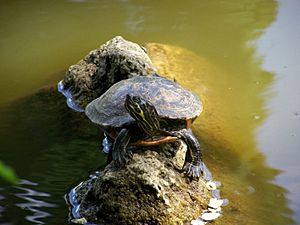Eastern river cooter facts for kids
Quick facts for kids Pseudemys concinna concinna |
|
|---|---|
 |
|
| Scientific classification |
|
| Kingdom: | Animalia |
| Phylum: | Chordata |
| Class: | Reptilia |
| Order: | Testudines |
| Suborder: | Cryptodira |
| Family: | Emydidae |
| Genus: | Pseudemys |
| Species: | |
| Subspecies: |
P. c. concinna
|
| Trinomial name | |
| Pseudemys concinna concinna (LeConte, 1830)
|
|
The eastern river cooter (Pseudemys concinna concinna) is a type of turtle found in the eastern United States. You can also find a smaller group of them in the Midwest. These turtles love living in freshwater places like rivers, lakes, and ponds.
Contents
About the Eastern River Cooter
The eastern river cooter is a specific kind of subspecies within the larger group called the river cooter. Think of a subspecies as a slightly different version of an animal that still belongs to the same main species. Most experts agree there are two main types of river cooters: the eastern river cooter (P. c. concinna) and the Suwannee cooter (P. c. suwanniensis).
What Does the Eastern River Cooter Look Like?
Eastern river cooters can grow quite large, up to about 42 centimeters (16.5 inches) long. Their upper shell, called the carapace, is usually dark greenish-brown. It often has a "C" shaped mark pointing towards the back. In some areas, this "C" might be smaller, and the shell can have many yellow spots. The main color of their shell is reddish-brown.
Their bottom shell, called the plastron, is yellow to reddish-orange. It has a dark pattern that follows the lines between the shell plates, but this pattern fades as the turtle gets older. This helps tell them apart from other similar turtles. They also have a stripe on their back feet. Female turtles usually grow bigger than males.
How Do They Breathe Underwater?
One amazing thing about the eastern river cooter is its special ability to breathe underwater! They have a unique sac called the cloaca bursae, located near their tail. This allows them to stay underwater for a long time. Because of this, it can be tricky for scientists to study them.
Where Eastern River Cooters Live and What They Eat
Eastern river cooters prefer areas where water flows, like rivers. But they also live in other freshwater spots. They like shallow areas with lots of water plants. If there are many turtles, they might live in deeper, clear water.
What Do Eastern River Cooters Eat?
In the wild, these turtles mostly eat aquatic plants and algae. About 95% of their diet comes from water plants. Younger eastern river cooters need more protein. So, they eat small water bugs, crabs, and even small fish. Older turtles might sometimes eat prey too, but they mainly stick to a plant-based diet.
Their Daily Life and Habits
You might sometimes see these turtles warming up in the sun. They are very shy and will quickly dive into the water if someone gets too close. Because they can breathe underwater, they are hard to spot once they are in the water. In warmer places, they are active all year. But in colder areas, they are less active during winter.
Eastern River Cooter Reproduction
The mating habits of eastern river cooters are similar to those of the red-eared slider. Male turtles are usually smaller than females. During mating season, the male will use his long claws to gently flutter them near the female's face. If the female is ready to mate, she will sink to the bottom of the river. Then, the male can mount her for mating.
Nesting and Hatching Eggs
After mating, the female will look for a place to lay her eggs. This usually happens several weeks later. They often cross roads to find good nesting spots on land. Females lay between 12 and 20 eggs at a time, always close to water.
Nesting usually happens from May to June. The female chooses a spot with sandy or soft soil, usually within 30 meters (100 feet) of the river's edge. She looks for an open area so the baby turtles can easily reach the water later. She digs the nest with her back feet. The eggs are oval-shaped, about 3.8 centimeters (1.5 inches) long.
The eggs hatch in about 45 to 56 days, but this can vary with temperature. Most hatchlings come out in August or September. Sometimes, if eggs are laid late in the season, the baby turtles might stay in the nest through their first winter and hatch in the spring. A baby eastern river cooter has a round shell, about 3.8 centimeters (1.5 inches) across. Their shell is green with bright yellow markings.

